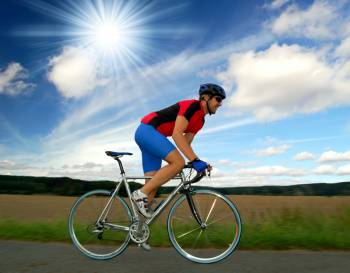|
|
Guide for Selecting Cycling EquipmentPhysiotherapy in Regina, Physiotherapy for CyclingWelcome to Alpha Center's guide for selecting cycling equipment. We recommend a few general considerations for selecting your equipment in order to stay comfortable and minimize injury while cycling. The basic equipment you will require for cycling is a bike and helmet. Of course, there are plenty of optional extras, and, as for all outdoor sports, don't forget you'll need to plan for sun protection and hydration too.
Bike:The type of bike you use will vary depending on the type of cycling you are interested in, how much time you spend cycling and your budget. Most important for your comfort as a cyclist is that the bike you use fits you. If you are purchasing your own bike, go to a shop that specializes in cycling, so that the salesperson is able to select the right frame size for you and adjusts the bike correctly for you based on your body dimensions and cycling needs. A borrowed bike should also be adjusted to suit your height from crotch/groin to the ground ("saddle height") and your upper body dimensions ("handlebar reach"). As a general guide, when you are seated on the saddle and your heel is resting on the pedal in the 6 o'clock position your knee should be bent between 0 and 15 degrees. When your hands are in position on the handles and you are seated on the saddle there should be a slight bend at your elbows. For endurance cycling and recreational riding the saddle is usually kept level. With your bike adjusted for this position, take a test ride and check that you feel comfortable, you can breath properly and your pedaling feels efficient. Helmet:A hard-shell bicycle helmet will protect your head, brain and upper and mid face should you have a collision on road or off. (Ref: http://injuryprevention.bmj.com/cgi/content/full/13/3/190.) Your helmet should be certified by the CSA (Canadian Standards Association) or CPSC (Consumer Product Safety Commission in the U.S.). Before you buy a helmet, try it on. The helmet should be stable on your head before you do up the straps. Once the straps are fastened the helmet should not move at all as you move your head. Sun Protection Gear:If you are cycling outdoors apply sunscreen and lip balm before you ride. Select clothing that will offer sun protection. Don't forget sunglasses which will not only protect your eyes from the sun, but also from insects and the wind. Hydration Gear:Keeping hydrated will help you stay alert while cycling, may help to prevent muscle cramps and will help your post ride recovery. Fit your bike with a drink bottle cage and water bottle or use a hydration backpack. We recommend that you drink about 300-400 mL before you ride (ref: http://www.ausport.gov.au/sportscoachmag/nutrition2/pre-event_nutrition), and 250mL (1 cup) of water or sports drink every 20 minutes of cycling (ref: http://pediatrics.aappublications.org/cgi/content/full/106/1/158) and for one hour after you cycle. Your fluid requirements will vary depending on the environmental conditions and your body size. To check that you are adequately hydrating, you can weigh yourself before and after you cycle. If your weight remains the same then you are likely to be well hydrated. Optional Extras:Safety reflectors,lights and bells: |
